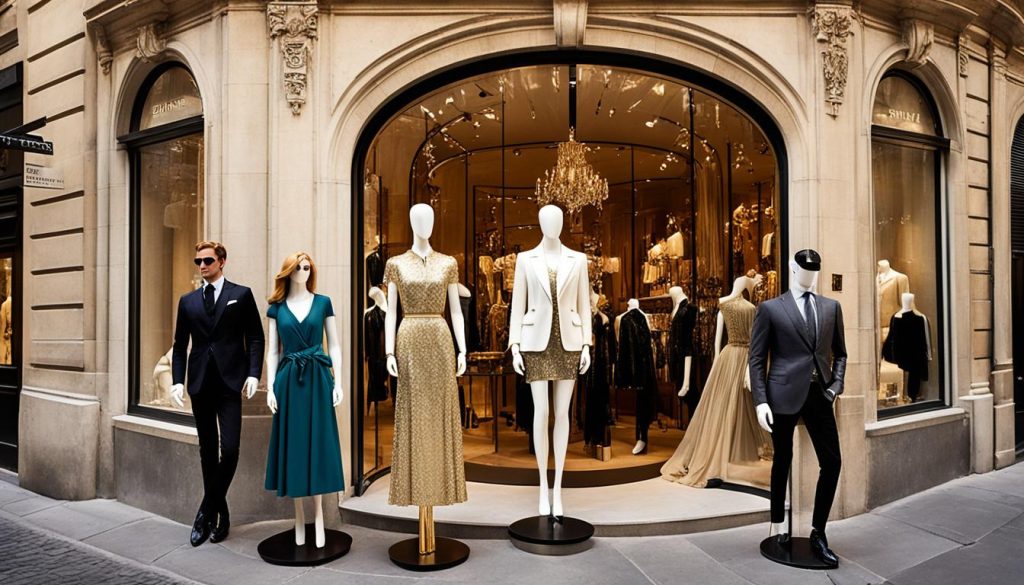“Fashion is the armour to survive the reality of everyday life.” – Bill Cunningham. This quote is very true for those dreaming of a fashion career in Italy’s glamour. Starting a boutique in Italy means combining creativity with business in a place full of style and history. From Milan’s chic streets to Florence’s artistic charm, Italy is perfect for those starting their fashion business journey. It’s a global fashion capital, offering a chance to make your mark in a changing industry.
Key Takeaways
- Italy is famous for its rich fashion history and is a key spot for fashion trends.
- Starting a boutique lets you turn your fashion dream into reality.
- The unique culture of Italy can make your boutique stand out.
- Finding out who your customers are is key to doing well in fashion.
- Knowing the local market is vital for your boutique’s success.
- Good branding and marketing can make your boutique unique in a crowded market.
- Building strong relationships with suppliers can help your boutique grow.
Understanding the Boutique Business Model

The boutique business model is all about giving shoppers something special. It’s different from big fashion stores. Boutiques offer unique items that match the style and tastes of their customers. They also focus on many other things to make their business work well.
Key Components of a Successful Boutique
There are key parts that make a boutique successful. These include:
- Product Selection: Choosing the right products is crucial. By offering unique and trendy items, boutiques can draw in customers looking for something special.
- Customer Service: Great customer service builds loyalty. When customers feel valued, they come back.
- Branding: A strong brand helps a boutique stand out. Good branding makes the store’s unique value clear to customers.
- Pricing Strategies: Prices must be right to balance value and affordability. Boutiques need to offer quality at a good price to stay competitive.
To make a boutique successful, it’s important to know how these parts work together. By focusing on unique items and personal shopping experiences, boutiques can keep customers coming back.
Why Italy is the Perfect Location for Your Boutique

Setting up a boutique in Italy brings unique benefits from its deep culture and strong economy. It’s a top spot for those wanting to enter high-end retail. Italy’s culture values art and skill, making it ideal for a boutique.
Cultural Advantages
Italy is a hub for fashion, known for its lively culture that loves creativity and style. The main cultural benefits are:
- Access to unmatched artisanal skills, with artisans who make designs come alive.
- A customer base that cherishes unique items with an Italian touch.
- Close to famous fashion events like Milan Fashion Week, which attracts global attention.
Economic Factors
Italy’s economy is key to boosting boutique retail. Several factors make it a great place for fashion shops:
- Millions of tourists each year looking to buy quality fashion.
- A strong retail market with both local and international shoppers wanting genuine Italian goods.
- Growing online shopping chances for boutiques to connect with people worldwide.
Researching the Italian Fashion Market

To understand the Italian fashion market, you need a good plan for market research. It’s important to know the latest trends and how consumers are changing. This can really help your boutique do well. You should look at reliable data from places like Statista and local fashion councils.
Market Trends
The Italian fashion market is known for its deep history and new ideas. There’s a growing interest in sustainable and ethical fashion. People want to buy from brands that are good for the planet and open about how they make things.
This change is a big chance for new boutiques that share these values.
Consumer Behaviour
Consumers are now looking for shopping experiences that feel personal. They want items that match their unique style. This change affects what they decide to buy.
Online shopping has also changed how people shop. It’s made it easier for them to find and buy things. Knowing these changes helps boutique owners make better choices and connect with their customers.
Choosing the Right Style for Your Boutique

Creating a unique boutique style is key to standing out. It means finding a specific niche that matches the latest fashion trends. This niche should appeal to a clear target audience. Knowing your niche helps in making marketing strategies and building a strong brand identity.
Identifying Your Niche
Finding your niche is crucial for success in the fashion world. It could be eco-friendly fabrics, luxury, or vintage collections. A clear niche will attract the right customers. Here are steps to define your boutique’s niche:
- Research current fashion trends to understand what styles are popular.
- Look for gaps in the market and see where your boutique could stand out.
- Analyse successful competitors to learn from their strategies.
Target Audience
After setting your boutique style and niche, it’s important to know your target audience. A clear customer profile will guide your buying and marketing. Consider these factors:
- Demographics: Age, gender, income, and lifestyle.
- Shopping behaviour: How often they shop and what they look for.
- Feedback: Talk to potential customers to understand their style and why they buy.
Location Matters: Finding the Ideal Spot for Your Boutique

Finding the right spot for your boutique is key to its success. Choosing between an urban or suburban location affects how easy it is for customers to get there and how well it does in sales. Each place has its own benefits for different types of businesses and customers.
Urban Versus Suburban
Urban and suburban areas offer different chances for finding a good spot. Cities have lots of people and well-known shopping areas, which means more people walking by. This can bring in a wide range of customers and lead to more impulse buys.
On the other hand, suburban areas might have lower rent and a closer community feel. This can attract customers looking for a calm shopping experience.
Foot Traffic Considerations
How many people walk by a location is crucial for a boutique’s success. Places with lots of people walking by can make your shop more visible and bring in more visitors. Watching how many people walk by at different times can tell you what customers are like.
Finding a spot with a lot of foot traffic is important. It makes sure your shop gets seen and increases the chances of making sales.
Legal Requirements for Opening a Boutique in Italy

Starting a boutique in Italy means knowing the legal rules you must follow. It’s important to understand how to register your business and follow local laws. This guide will help you set up your boutique and follow Italy’s business laws.
Business Registration Process
To register your business in Italy, start with a detailed business plan. This plan should cover your boutique’s idea, who you want to sell to, and how much money you expect to make. Then, you need to do the following steps:
- Choose a legal form for your boutique, like being a sole trader or a limited company.
- Register your business name at the local Chamber of Commerce.
- Get a tax ID number (Codice Fiscale) from the Agenzia delle Entrate.
- Apply for permits needed for a retail shop, like health and safety approvals.
Tax Considerations
Knowing about taxes is key to keeping your boutique running in Italy. You’ll need to handle different taxes, including:
- Value Added Tax (VAT) on what you sell.
- Income tax on what your boutique makes.
- Regional taxes that depend on where your business is.
Creating a Compelling Boutique Brand Identity

Creating a strong brand identity is key for any boutique to stand out in the fashion world. It’s not just about a name or logo. It’s about how customers feel about the brand. By focusing on branding elements and sharing the vision, boutiques can make a lasting impression.
Branding Elements
A strong brand identity has many parts that work together. Important parts include:
- Logo design: This is the visual symbol of your brand and should show its personality and values.
- Colour schemes: Choosing colours carefully can make people feel certain emotions and connect with your audience.
- Typography: The fonts you use should match your boutique’s style and help people remember your brand.
- Storytelling: A good story about your brand can make customers feel closer to it, helping them connect with your boutique.
Communicating Your Vision
Sharing the boutique’s vision and values is crucial for keeping customers loyal. Here are some ways to do this:
- Use social media to tell the story of your brand, showing what inspires and drives your fashion store.
- Be active in community events and projects to show your brand’s positive values.
- Make sure your message is the same everywhere, so your branding matches what customers expect.
The Importance of Supplier Relationships

For a boutique to do well, building strong supplier relationships is key. Having reliable suppliers means you get high-quality products and run smoothly. They help keep your store stocked and your customers happy.
Having a good network of suppliers helps you keep your products top-notch and get them on time. This is crucial for keeping your customers coming back.
Identifying Reliable Suppliers
When searching for suppliers, look at these things to make sure they’re trustworthy:
- Check references and reviews from other boutiques.
- Look at their production skills and how fast they deliver.
- See how well they communicate and treat their customers.
- Make sure they follow the rules of the industry.
Negotiating Terms
After finding reliable suppliers, it’s important to negotiate good terms. You want deals that help your boutique succeed. Look for agreements that include:
- Prices that are good for your profit.
- Payment options that fit your budget.
- Delivery times that don’t leave you short on stock.
- Ways to check the quality of products.
Marketing Strategies for Your Boutique

Marketing your boutique needs a mix of offline and online tactics. Fashion retail marketing is all about being creative and engaging. It’s key to use different ways to grab the attention of potential customers. Knowing how to use these methods can really help your boutique stand out and increase sales.
Offline Strategies
Traditional marketing still has a lot to offer in the boutique world. Here are some effective offline strategies:
- Hosting local fashion shows and trunk shows to show off new collections.
- Working with nearby businesses for joint events.
- Using flyers and posters in the local area to draw in customers.
- Being part of community fairs and markets to boost brand visibility.
Digital Marketing
Online marketing is key in today’s digital world for fashion retail. Here are some digital strategies to consider:
- Having a strong social media presence on platforms like Instagram and Facebook.
- Sending targeted email campaigns to tell customers about sales and new items.
- Working with influencers to reach more people and gain trust.
- Using search engine optimisation to make your website more visible.
Operating Costs: Budgeting for Your Boutique

For those dreaming of opening a boutique, understanding the financial side is key. Good budgeting is the first step towards success. Knowing what you’ll need to spend upfront and on a regular basis helps avoid surprises.
Initial Investment
The cost of starting a boutique can change a lot, depending on where it’s located and how big it is. Important costs include:
- Renovation and interior design costs
- Inventory expenses
- Licensing and legal fees
- Initial marketing and promotional expenses
- Equipments like point of sale systems and furniture
Knowing these costs well helps set a solid financial base. It makes getting the right funding easier, whether from savings, loans, or investors.
Ongoing Expenses
After opening, it’s crucial to keep an eye on ongoing costs. These can include:
- Rent and utilities
- Salaries and employee benefits
- Inventory replenishment
- Marketing efforts
- Miscellaneous costs such as maintenance and supplies
Keeping track of these costs helps owners manage their finances well. Regular budget reviews and adjustments keep the boutique financially healthy. This also supports growth plans.
Customer Experience: Designing Your Boutique Space

Creating a captivating boutique design is key to a great customer experience. A well-thought-out layout draws in customers and makes them want to stay and explore. The design and atmosphere greatly affect how customers feel about your boutique, which boosts satisfaction and loyalty.
Layout and Flow
The way your boutique is laid out is vital in guiding customers around. A good layout makes sure customers can move easily and see products well. Important things to think about include:
- Logical pathways that lead customers through different sections
- Strategic placement of high-demand items to draw attention
- Comfortable spacing to avoid crowding and facilitate browsing
Ambiance Creation
Creating a welcoming atmosphere makes the customer experience better. The vibe should match your boutique’s brand and appeal to your target audience. Think about these things for a memorable atmosphere:
- Lighting that highlights products while creating a warm environment
- Music that aligns with brand values and resonates with customers
- Decor elements that tell a story and enhance the boutique design
Utilising Online Presence to Boost Your Boutique Sales

In today’s market, having a strong online presence is key. It helps boutiques be seen by more people. Using e-commerce is vital for selling more online.
E-commerce Opportunities
Creating a good e-commerce site lets boutiques show their unique items to people all over the world. Important things to think about include:
- Simple navigation for an enjoyable shopping experience.
- High-quality images and detailed descriptions of products.
- Secure payment options to instil customer confidence.
Adding these features can really help increase online sales and make customers happier.
Social Media Engagement
Social media is great for talking to potential customers and building a community around your boutique. On platforms like Instagram and Facebook, boutiques can:
- Share behind-the-scenes content to humanise the brand.
- Offer exclusive promotions to loyal followers.
- Encourage user-generated content to foster community relations.
This helps bring more people to your online stores and builds a loyal customer base. This leads to more digital sales.
Hiring the Right Team for Your Boutique

Building a strong team is key to a boutique’s success. The right staff not only shares the boutique’s vision but also boosts customer service. Start by clearly outlining roles and responsibilities. Then, use a smart hiring strategy.
Offering ongoing training and development chances is crucial. It keeps the team motivated and maintains high standards in team management.
Defining Roles
Clear roles help each team member know their part. Common positions in a boutique include:
- Sales Associates
- Store Managers
- Visual Merchandisers
- Customer Service Representatives
These roles should match the boutique’s staffing needs. This ensures customers get the best service, which is key for loyalty.
Training and Development
After hiring, it’s vital to provide thorough training. Offering continuous development chances helps staff do their best. Consider these ideas:
- Orientation sessions for new staff
- Workshops on product knowledge
- Regular feedback sessions to identify growth areas
Successful boutique owners stress the value of investing in staff. A committed team leads to more sales and happier customers. This underlines the importance of a strong approach to hiring and development.
Building a Loyal Customer Base for Your Boutique

Creating a loyal customer base is crucial for any boutique’s long-term success. Using effective strategies can greatly improve customer loyalty. It’s important to build an emotional bond with customers and offer top-notch service to bring them back.
Loyalty Programs
A well-thought-out loyalty programme is a great way to thank your regular customers. Think about adding these features to your programme:
- Give points for purchases that can be swapped for discounts or special items.
- Have different rewards levels to motivate customers to spend more.
- Offer special deals to loyalty programme members on their birthdays or special occasions.
These steps can make customers feel important and valued. It will help increase the number of people coming to your store and boost sales.
Engaging Customer Feedback
Listening to what customers say can make your boutique more appealing. Here are ways to connect with customers:
- Use surveys to find out how happy they are and what they think could be better.
- Join social media to get immediate feedback.
- Set up suggestion boxes in-store for customers to share their thoughts.
By listening to customers, you can make changes to meet their needs. This keeps customers coming back and helps your boutique stay true to its audience.
Future Trends in the Boutique Sector in Italy
In Italy, the boutique scene is changing fast. Two big trends are making a mark: sustainability and digital transformation. More people now want to buy from shops that care for the planet. This means boutiques are focusing on being more eco-friendly to keep customers happy.
This move also puts them at the lead in the fight against fashion’s environmental issues.
Sustainability in Fashion
Sustainability is key in fashion now. Shoppers want clothes that look good and don’t harm the earth. They’re looking for items made from local materials, by skilled hands, and with clear supply chains.
By going green, boutiques meet what customers want and stand out in a crowded market.
Digital Transformation
Digital changes are big for boutiques. New tech is changing how shops work and talk to customers. Online shopping meets the real world, making it easy for customers to buy what they like.
Using social media and online ads helps boutiques get noticed and engage with shoppers. This way, they can stay ahead in the ever-changing fashion world.









